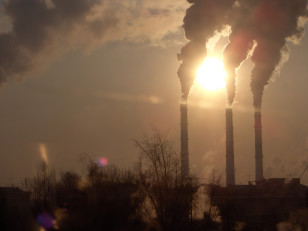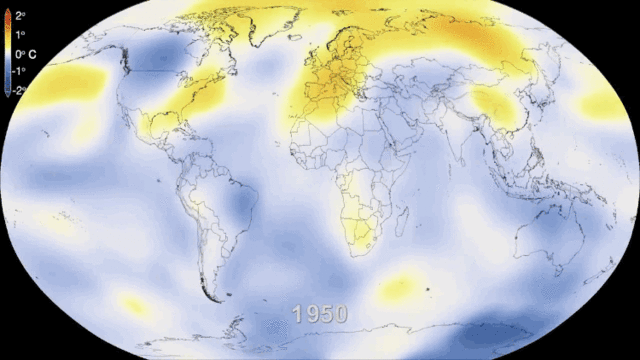A Canadian physicist says his studies have all but completely ruled out the premise that global warming throughout the industrial era has not been merely a natural fluctuation in Earth’s climate, as some have been claiming. The assertion was made after the scientist analyzed temperature data from as far back as 1500.

McGill University study says that there’s a 99% chance that global climate change is man-made (otodo via Flickr/Creative Commons)
“This study will be a blow to any remaining climate-change deniers,” said study author Shaun Lovejoy who is also a professor of physics at McGill University in Montreal. “Their two most convincing arguments – that the warming is natural in origin, and that the computer models are wrong – are either directly contradicted by this analysis, or simply do not apply to it.”
Published in a recent edition of the journal Climate Dynamics, the study, based on statistical analysis of historical data rather on complex computer models used in previous studies, provides a new perspective to the question of what is behind global warming trends.
Lovejoy said that his analysis led him to conclude “with confidence levels great than 99%, and most likely greater than 99.9%,” that global warming since 1880 has been mostly caused by man-made emissions from the burning of fossil fuels and long-term temperature variations not caused by nature.
The historical temperature data Lovejoy used for times prior to the industrial era (before 1760) were estimates that were made from “multi-proxy climate reconstructions” that had been developed by scientists in recent years.
The climate reconstructions took into consideration a variety of natural indicators such as information from tree rings, ice cores, and lake sediments.
For his data from the industrial era, Lovejoy used levels of carbon-dioxide produced by the burning of fossil fuels as a representation for all human caused climate changes, since there has been a close relationship between the world’s economic activity and the release of greenhouse gases and particulate pollution.
“This allows the new approach to implicitly include the cooling effects of particulate pollution that are still poorly quantified in computer models,” said Lovejoy.

This visualization shows a running five-year average global temperature, as compared to a baseline average global temperature from 1951-1980. (NASA GISS)
Lovejoy said that his findings complement those made in a report just released by the UN’s IPCC. He said that his study predicted, with 95% confidence, that doubling the carbon-dioxide levels in the atmosphere would increase global temperatures between 1.9 and 4.2 degrees Celsius. The IPCC’s prediction puts the rise in temperature between 1.5 to 4.5 degrees Celsius if atmospheric carbon-dioxide levels double.
“We’ve had a fluctuation in average temperature that’s just huge since 1880 – on the order of about 0.9 degrees Celsius,” said Lovejoy. “This study shows that the odds of that being caused by natural fluctuations are less than one in a hundred and are likely to be less than one in a thousand.”





















No it’s 96.7% of all scientists are 95% certain THE END IS NEAR and 100% certain the planet is not flat but CO2 COULD flatten it, they say.
http://www.winnipegfreepress.com/opinion/analysis/think-the-past-winter-was-bad-get-ready-for-mini-ice-age-254851541.html
Now the scientists are saying Ice age.
HAHAHAHAHAHAHAHA Ohhhhhh this is priceless.
If you read that article you’d have learned that the warm air currents that have been reliably bringing in warm air from the equator are abruptly changing. These changes could result in a new pattern where the Northern hemisphere is no longer being warmed by air currents, therefore dropping it into cooler temperatures. This would also mean that the equatorial air will retain more of its heat, causing more severe weather patterns.
With our atmosphere holding onto more thermal energy (thanks to high levels of CO2) we may find that we won’t see dependable weather patterns for a very long time, meaning North American, European, and Russian crop failures will be unavoidable; increasing political pressures as food prices rise and ‘safe’ growing regions struggle to keep up with demand.
There is a lot of uncertainty as to what the resulting world will look like due to our actions, but all changes bring extraneous costs and its the tax payers who will foot the bill while the industries most responsible for blocking preventative measures will continue to collect subsidies.
Research studies not in the hands of economic power elites, will not be able to detour current trend of destruction. Grief will produce the ultimate fact.
Disgracefully, science and developments have historically been subdued to benefit an elite, instead of humanity. Benefits to humanity has been a by-product, actually sold very expensively to humanity, and of debatable actual value, to some extend.
Mankind no; …powerful “economic elite” will continue destroying our habitat, while the scientists will continue tellinng them, …what they do not need to hear.
I basically agree with the article on the fact that global climate change is man man made. Essentially, what turns to be the main problem here is that many countries are mainly focused on developing their industries and benefiting from them more than they are concerned about the state or health of our habitat as a whole. carbon dioxide levels are increasing every single minute in the atmosphere. This is mainly because of an uncontrolled rate of emissions from most developed countries. I take it as a selfish practice because only the developed countries benefit from this, and the other countries only benefit from catastrophes. heavy rainfalls, floods, Tsunami’s etc……..poor countries together with developing countries have no say about any decisions made about maintaining the greenhouse effect. Instead, they tend to obey more to them than other developed countries. I feel that each and every country should follow a certain quotas and obey to it. This would regulate the amount of harmful gases in the atmosphere and generally benefit everyone. If success is one thing that a country strives for, it should be done through healthy conditions and not under great suffer of other countries. Basic rule is that we all want to live and be successful through industrial activities but it should all be done under moderated conditions. Based on Scott’s post, do you think that these current changes might lead to a development of Monsoons ? – I don’t know if my point makes sense or not but i believe that we should work on a plan on how to solve the problem since it has been identified.
Are these Scientists not the elite you speak of? Are these scientists not part of the global money pit that funds anything agreeing with the golden CO2 theory!
I think we need some perspective here! ‘99.9% Does not sound like it comes from a scientist’
Our climate has never been fixed. 1500-2014 is a mere blink in the history of our earths climate. There has been much more C02 in Geological history – It has been much cooler, and hotter.
Are we 99.9% sure we are not fooling our selves! That we misuse statistics because we want funding? A nice headline, it sounds precise, but is it accurate, is it science? Or is it politics in disguise.
Science or politics in disguise, the evidence to us very clear in terms on changing weather patterns such as increase occurrence in the amount of rainfall and tornado occurrence. Ye s it is quite unfair that the developing countries get to pay for human ignorance where as developed countries get to become wealthier at the expense of our planet. As part of the human race I believe we should put the greediness aside and work together to preserve our planet for ourselves and the benefit for the future generation. If scientist research is based on accurate data then I rather suggest that they focus more of their energy in preserving the environment than promoting luxurious lives. This is not only the responsibility of scientist but also for us(people) all over the world to reduce, re-use and re-cycle in order to sustain tomorrow’s lives.
Wow! This evidence is pretty solid as it is clearly verified. It is a clear as daylight that global warming is man made. Man is increasing the amount of CO2 daily by his activities. 31 billion tons of CO2 is released daily, this is not child play. It is good to know the cause of global warming but at this stage the pointing game will have no effect. Where to from now? Governors of the world should work hand in hand with ecologist to protect our abode. Greed should not govern the world but responsibility should.
It has been quiet a learning curve learning of the contrary views on global warming. It is amazing that 30% of Americans do not believe global warming is true. But it is sad that this disaster has no mercy and the damage is exponentially going out of proportion. The million dollar question is what are we going to do to curb this man made disaster? As the only culprit to blame is man.